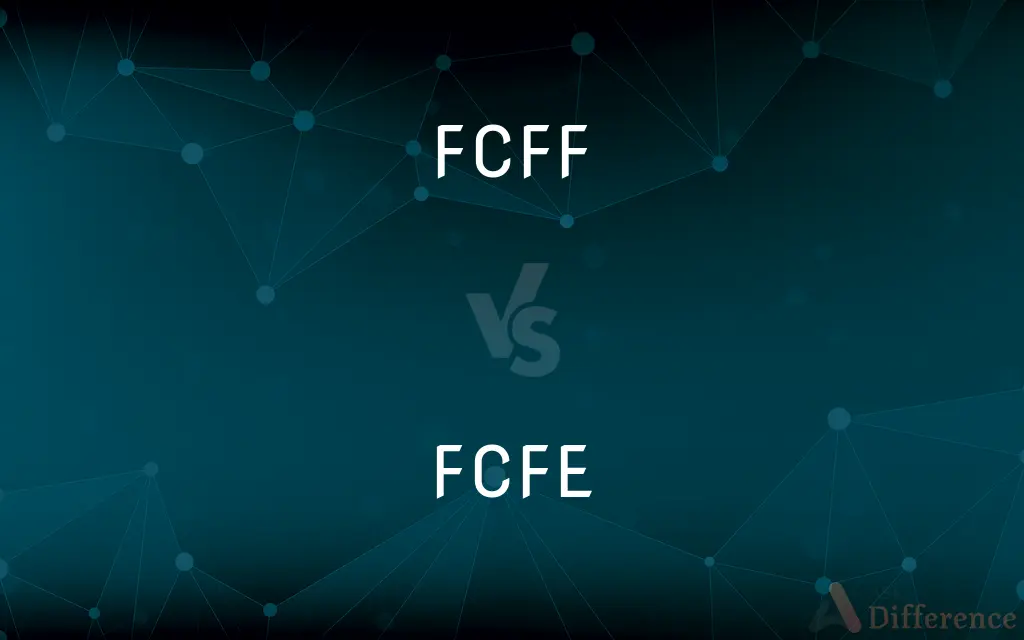FCFF vs. FCFE — What's the Difference?
Edited by Tayyaba Rehman — By Fiza Rafique — Published on January 10, 2024
FCFF (Free Cash Flow to the Firm) measures cash flow available to all investors, while FCFE (Free Cash Flow to Equity) is cash flow left for shareholders after debts are paid.

Difference Between FCFF and FCFE
Table of Contents
ADVERTISEMENT
Key Differences
Free Cash Flow to the Firm (FCFF) is a measure of a company's financial performance that represents the cash that's available to all capital providers, both equity and debt holders. FCFE, on the other hand, is the Free Cash Flow to Equity, measuring the cash available only to the company’s equity shareholders after all debts and operational expenses have been paid. FCFF takes a more holistic approach by considering the total investment outlay needed to maintain the business, while FCFE focuses on the net benefit to shareholders.
When analyzing a company using FCFF, an investor gets a view of the cash that the company can generate without the need for external financing. This includes cash that can be used to pay dividends, buy back shares, or repay debt. FCFE analysis, however, will show the cash flow that remains after accounting for reinvestment in working capital and fixed capital, and after meeting debt service requirements. FCFF is therefore useful for valuing the entire company, while FCFE is tailored to equity valuation.
FCFF is a valuable tool for investors looking at companies with complex capital structures or those that are highly leveraged. It provides a picture that is not distorted by the effects of debt financing. In contrast, FCFE gives a clearer picture of the potential dividends and growth available to equity investors, which can be particularly relevant for companies that are financed primarily with equity or have stable debt structures.
When considering the calculation, FCFF is derived by adjusting the operating income for taxes, adding back depreciation and amortization, subtracting changes in working capital, and subtracting capital expenditures. FCFE starts with FCFF and further adjusts for net borrowing, showing how much cash is available to equity holders after all expenses and debts are paid. Hence, FCFE can be negative if the debt payments exceed the cash flows from operations, whereas FCFF is always positive as long as the firm has positive operational cash flow.
In summary, FCFF and FCFE serve different purposes in financial analysis. FCFF is a broad indicator of a company's cash generation ability, useful for valuing a business as a whole. FCFE is more specific, showing how much cash could potentially be distributed to equity shareholders. Both are critical in different contexts, with FCFF preferred by creditors and potential acquirers and FCFE favored by equity investors.
ADVERTISEMENT
Comparison Chart
Beneficiaries
All capital providers
Equity shareholders only
Debt Consideration
Ignores debt payments
Includes debt payments
Usage
Valuation of the entire company
Valuation of equity only
Starting Point
Operating income
FCFF minus net debt financing
Significance
Preferred by creditors and acquirers
Preferred by equity investors
Compare with Definitions
FCFF
FCFF represents cash available to creditors and investors.
The company's high FCFF indicates strong financial health.
FCFE
FCFE factors in debt payments, reflecting equity holders' claims.
Their negative FCFE may delay any equity returns.
FCFF
FCFF is unaffected by capital structure decisions.
Despite changing debt levels, the FCFF remained stable.
FCFE
FCFE represents residual cash flow after funding all project expenses.
A soaring FCFE has set the stage for aggressive stock buybacks.
FCFF
FCFF is earnings before interest after taxes plus non-cash charges minus capital expenditures.
Their FCFF outpaces their net income, suggesting robust cash generation.
FCFE
FCFE is useful in calculating the intrinsic value of equity.
Analysts highlight a high FCFE when justifying the stock's target price.
FCFF
FCFF determines a firm's ability to create value for all stakeholders.
Stakeholders are impressed by the consistent FCFF growth.
FCFE
FCFE is the cash flow available for distribution to equity shareholders.
The company's FCFE supports a potential dividend increase.
FCFF
FCFF is the cash a firm can generate for financing activities.
With substantial FCFF, the firm can easily fund its expansion.
FCFE
FCFE measures financial performance from an equity perspective.
Investors cheered the consistent rise in FCFE.
Common Curiosities
What is FCFF used for?
FCFF is used to assess the cash available to all investors, both debt and equity.
Is FCFF influenced by how a company is financed?
No, FCFF is not influenced by the capital structure, as it calculates cash flow before debt payments.
How is FCFE calculated?
FCFE is calculated from FCFF by subtracting net debt financing (debt repayments less new debt issued).
Why is FCFF important for creditors?
Creditors prefer FCFF as it shows the cash flow available for debt servicing before equity distributions.
Is FCFF always positive?
FCFF is typically positive if the company has positive operating cash flow, but can be negative if operational costs exceed revenues.
Can FCFE be negative?
Yes, FCFE can be negative if a company has large debt obligations that exceed its cash flow from operations.
Which is better for dividend analysis, FCFF or FCFE?
FCFE is better for dividend analysis as it reflects the cash available after debt servicing.
Who uses FCFF for valuation?
Both equity investors and creditors use FCFF for valuing the whole company, not just equity.
How do non-cash charges affect FCFE?
Non-cash charges like depreciation are added back in the calculation of FCFF before determining FCFE.
Do you need net income to calculate FCFE?
No, FCFE is typically calculated using FCFF, not net income, and adjusts for net debt issued or repaid.
Does FCFE consider reinvestment needs?
Yes, FCFE considers reinvestment in working and fixed capital before providing for equity holders.
Can you use FCFF to assess dividend sustainability?
Yes, but it is less direct than using FCFE, which more closely relates to dividends.
Is FCFE useful for highly leveraged companies?
FCFE can be less relevant for highly leveraged companies as debt payments can overshadow equity considerations.
What impacts FCFF directly?
Operating income, taxes, working capital changes, and capital expenditures impact FCFF directly.
What happens to FCFE when a company takes on more debt?
FCFE may increase if the debt is used for activities that generate cash flows exceeding the cost of the new debt.
Share Your Discovery

Previous Comparison
Aspect Ratio vs. Resolution
Next Comparison
Acetone vs. Nail Polish RemoverAuthor Spotlight
Written by
Fiza RafiqueFiza Rafique is a skilled content writer at AskDifference.com, where she meticulously refines and enhances written pieces. Drawing from her vast editorial expertise, Fiza ensures clarity, accuracy, and precision in every article. Passionate about language, she continually seeks to elevate the quality of content for readers worldwide.
Edited by
Tayyaba RehmanTayyaba Rehman is a distinguished writer, currently serving as a primary contributor to askdifference.com. As a researcher in semantics and etymology, Tayyaba's passion for the complexity of languages and their distinctions has found a perfect home on the platform. Tayyaba delves into the intricacies of language, distinguishing between commonly confused words and phrases, thereby providing clarity for readers worldwide.












































